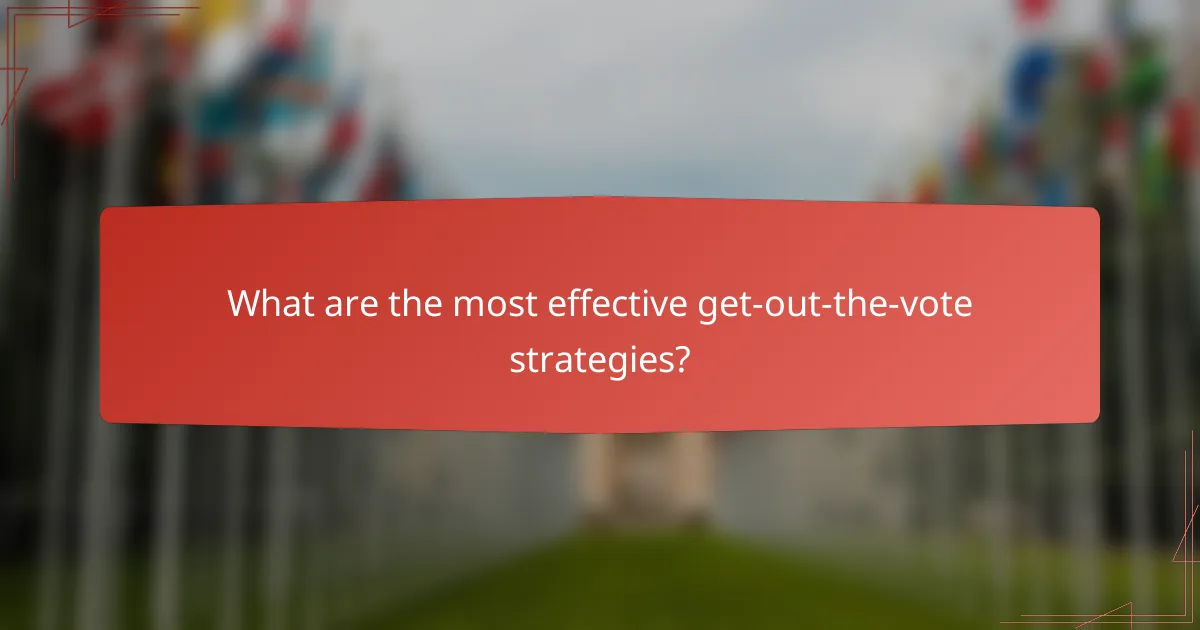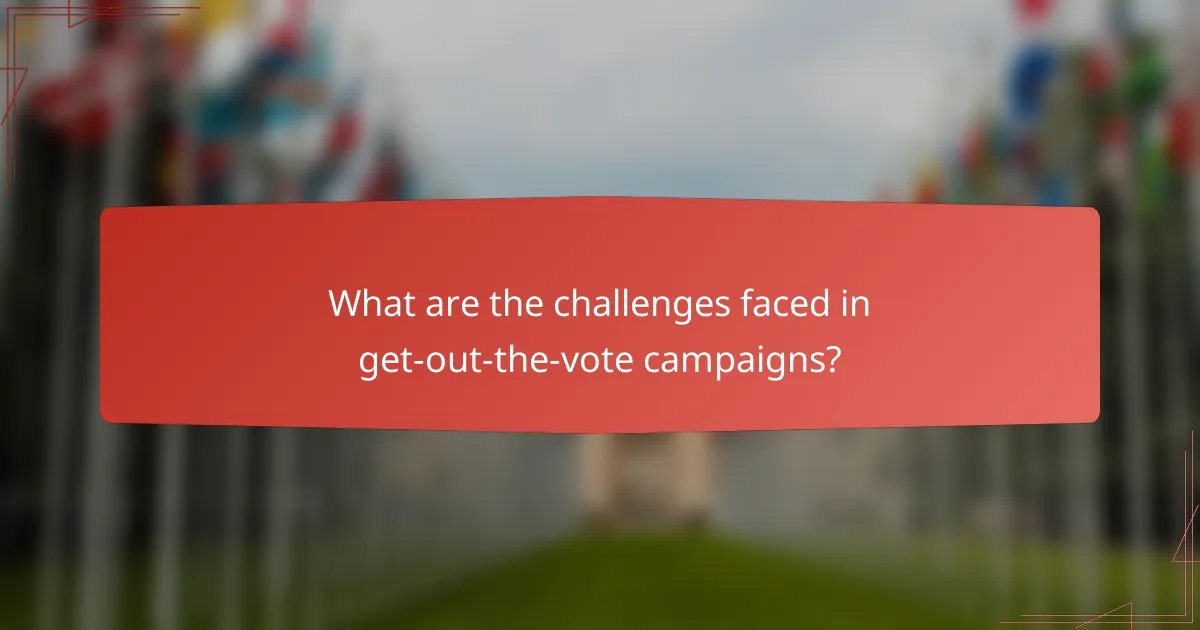Get-out-the-vote efforts play a crucial role in shaping election outcomes by enhancing voter participation through targeted engagement strategies. By utilizing personal interactions and technology, these initiatives aim to inform and motivate voters, particularly those from demographics that typically have lower turnout rates. To evaluate their effectiveness, key metrics such as voter turnout rates and demographic reach are employed, offering valuable insights into the impact of these mobilization efforts.

What are the most effective get-out-the-vote strategies?
The most effective get-out-the-vote strategies include direct engagement methods that encourage voter participation. These strategies leverage personal interaction and technology to reach voters, ensuring they are informed and motivated to cast their ballots.
Door-to-door canvassing
Door-to-door canvassing involves volunteers visiting homes to engage directly with voters. This method allows for personalized conversations, where canvassers can answer questions and provide information about voting logistics and candidates.
To maximize effectiveness, canvassers should be trained to communicate key messages clearly and handle objections. Scheduling visits during evenings or weekends can increase the likelihood of finding residents at home.
Text message outreach
Text message outreach uses SMS to remind voters about upcoming elections and provide essential information. This strategy is particularly effective due to the high open rates of text messages, often exceeding 90% within minutes of receipt.
Organizations should segment their audience to tailor messages based on demographics or past voting behavior. It’s crucial to comply with regulations regarding consent and opt-out options to maintain trust and legality.
Social media campaigns
Social media campaigns utilize platforms like Facebook, Twitter, and Instagram to engage voters through targeted ads and organic posts. These campaigns can spread awareness quickly and reach diverse demographics, especially younger voters.
Effective campaigns should include clear calls to action, shareable content, and interactive elements like polls or live Q&A sessions. Monitoring engagement metrics can help refine strategies and improve outreach efforts.
Phone banking
Phone banking involves volunteers calling voters to discuss the importance of participating in elections. This method allows for real-time interaction and can help clarify any voting-related questions or concerns.
To enhance effectiveness, phone bankers should follow a script but remain flexible to adapt to the conversation. Timing calls during evenings or weekends can improve contact rates, and tracking outcomes can help assess the impact of this strategy.
Community events
Community events, such as rallies or informational sessions, serve as platforms to mobilize voters. These gatherings can create a sense of community and urgency around voting, making participation feel more accessible and important.
Successful events should include engaging speakers, informative materials, and opportunities for attendees to register to vote. Collaborating with local organizations can help increase attendance and outreach effectiveness.

How do get-out-the-vote efforts impact election outcomes?
Get-out-the-vote efforts significantly influence election outcomes by increasing voter participation and shaping public engagement. These initiatives can lead to higher turnout rates, particularly among demographics that traditionally vote less, ultimately swaying election results.
Increased voter turnout
Get-out-the-vote campaigns are designed to mobilize voters, resulting in increased turnout during elections. Strategies such as door-to-door canvassing, phone banking, and targeted social media outreach can effectively reach potential voters, encouraging them to participate. Studies have shown that these efforts can raise turnout by several percentage points, particularly in competitive races.
To maximize effectiveness, campaigns should focus on identifying and targeting specific voter demographics, such as young voters or underrepresented communities. Tailoring messages to resonate with these groups can further enhance turnout rates.
Higher engagement in local issues
Effective get-out-the-vote efforts often lead to greater engagement in local issues, as voters become more informed about the candidates and measures on their ballots. When individuals participate in the voting process, they are more likely to discuss and advocate for local matters, fostering a sense of community involvement.
Campaigns can enhance this engagement by providing information on local candidates and issues through community events, informational flyers, and social media platforms. This not only boosts turnout but also encourages voters to stay informed and active beyond election day.
Influence on swing states
Get-out-the-vote initiatives play a crucial role in swing states, where elections can be decided by a small number of votes. In these areas, targeted efforts can significantly impact voter turnout, making them critical for both major political parties. Mobilizing voters in swing states can shift the balance of power in elections.
Campaigns should focus on understanding the unique demographics and concerns of swing state voters. Utilizing data analytics to identify key neighborhoods and tailoring outreach efforts accordingly can lead to more effective mobilization strategies in these pivotal regions.

What metrics are used to measure effectiveness?
To assess the effectiveness of get-out-the-vote efforts, several key metrics are commonly used. These include voter turnout rates, engagement statistics, and demographic reach, each providing insights into how well initiatives mobilize voters and target specific populations.
Voter turnout rates
Voter turnout rates indicate the percentage of eligible voters who actually cast their ballots during an election. This metric is crucial as it directly reflects the success of get-out-the-vote campaigns. For example, a turnout increase of just a few percentage points can signify a significant impact from targeted outreach efforts.
When analyzing turnout rates, consider comparing them across different demographics or regions. This can help identify which groups were most influenced by the campaign and where further efforts may be needed.
Engagement statistics
Engagement statistics measure how actively potential voters interact with campaign materials and outreach efforts. This can include metrics such as the number of phone calls made, text messages sent, or social media interactions. High engagement levels often correlate with increased voter turnout.
Tracking engagement can involve setting specific goals, like aiming for a certain number of interactions per week. Monitoring these statistics allows campaigns to adjust their strategies in real-time, focusing on the most effective methods of communication.
Demographic reach
Demographic reach assesses how well a campaign connects with various segments of the population, including age, race, and socioeconomic status. Understanding demographic reach helps campaigns tailor their messages to resonate with specific groups, increasing the likelihood of voter participation.
To effectively measure demographic reach, collect data on the demographics of those engaged versus the overall eligible voter population. This can reveal gaps in outreach and highlight areas where additional resources may be necessary to ensure inclusivity and representation in the voting process.

What organizations lead get-out-the-vote initiatives?
Several organizations play a critical role in leading get-out-the-vote initiatives, focusing on increasing voter participation through various strategies and outreach efforts. These organizations often employ grassroots campaigns, digital engagement, and educational resources to mobilize voters.
League of Women Voters
The League of Women Voters is a nonpartisan organization dedicated to empowering voters and defending democracy. They provide comprehensive resources, including voter registration assistance, candidate information, and educational materials about the voting process.
One effective strategy they use is hosting community forums and debates, which help inform voters about local issues and candidates. Their emphasis on nonpartisanship ensures that they remain a trusted source of information for all voters.
Rock the Vote
Rock the Vote focuses on engaging and building the political power of young people. Their initiatives include online voter registration, educational campaigns, and social media outreach to encourage youth participation in elections.
They often collaborate with artists and influencers to reach a broader audience, making voting more appealing and accessible. Their mobile app also simplifies the registration and voting process, allowing users to check their registration status and find polling places quickly.
Vote.org
Vote.org is a digital platform that aims to increase voter turnout through technology. They offer tools for voter registration, absentee ballot requests, and reminders about upcoming elections, making the voting process more straightforward for users.
By providing state-specific information and resources, Vote.org helps voters navigate the complexities of different voting regulations. Their user-friendly interface and comprehensive support make it easier for individuals to participate in elections, ultimately boosting voter engagement.

What are the challenges faced in get-out-the-vote campaigns?
Get-out-the-vote campaigns encounter several significant challenges that can hinder their effectiveness. Key issues include funding limitations, voter apathy, and legal restrictions, each of which can impact the ability to mobilize voters and ensure participation in elections.
Funding limitations
Funding is a critical component of any get-out-the-vote campaign. Limited financial resources can restrict outreach efforts, advertising, and the ability to hire staff or volunteers. Campaigns often rely on donations, which can fluctuate, making it difficult to maintain consistent messaging and engagement.
To mitigate funding challenges, campaigns should prioritize building a diverse funding base, including grassroots donations and partnerships with local organizations. Utilizing low-cost digital platforms for outreach can also help maximize impact while minimizing expenses.
Voter apathy
Voter apathy poses a significant barrier to effective get-out-the-vote efforts. Many potential voters feel disillusioned or believe their vote does not matter, leading to lower turnout rates. This lack of motivation can stem from negative perceptions of the political process or a lack of connection to the candidates and issues at stake.
To combat voter apathy, campaigns should focus on creating engaging narratives that resonate with the target audience. Highlighting local issues, personal stories, and the tangible impact of voting can help energize and motivate voters to participate.
Legal restrictions
Legal restrictions can complicate get-out-the-vote initiatives, as various laws govern voter registration, identification requirements, and campaign activities. These regulations can vary significantly by state or region, affecting how campaigns operate and engage with voters.
Understanding the legal landscape is essential for any campaign. It is advisable to consult legal experts to ensure compliance with local laws and regulations. Additionally, educating voters about their rights and the voting process can help navigate these restrictions and encourage participation.

How do demographics affect get-out-the-vote strategies?
Demographics significantly influence get-out-the-vote (GOTV) strategies by determining which methods are most effective for engaging different groups. Factors such as age, race, income, and education level shape the messaging, outreach methods, and resources needed to mobilize voters.
Age
Age is a critical demographic factor in shaping GOTV strategies. Younger voters, typically under 30, may respond better to digital outreach through social media and text messaging, while older voters might prefer traditional methods like phone calls or direct mail. Tailoring communication to these preferences can enhance engagement and turnout.
Race and Ethnicity
Race and ethnicity play a vital role in determining the effectiveness of GOTV efforts. Different cultural backgrounds may require unique messaging and outreach approaches. For instance, outreach to Hispanic voters often benefits from bilingual materials and community engagement, while African American voters may respond positively to efforts that highlight issues of social justice and equity.
Income and Education Level
Income and education levels can influence voter turnout and the types of issues that resonate with different demographics. Lower-income individuals may prioritize economic issues, while those with higher education might focus on policy details. GOTV strategies should consider these factors to address the specific concerns and barriers faced by various income and education groups.
Geographic Location
Geographic location affects demographic characteristics and, consequently, GOTV strategies. Urban areas may require different tactics compared to rural regions, such as leveraging local community organizations in cities versus door-to-door canvassing in less populated areas. Understanding local dynamics is essential for effective outreach.



